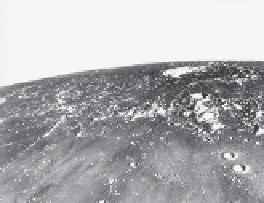Geology Reference
In-Depth Information
(a)
(b)
(c)
Figure 4.8. (a) A Lunar Orbiter photograph (LO IV M-126) showing
Copernicus crater (A), Eratosthenes crater (B), and Archimedes crater
(C). Copernicus is 107 km in diameter and is one of the youngest large
impacts on the Moon, serving as the type locality for the
stratigraphic Copernican System. (b) An oblique Apollo 17 view
(NASA AS 17
2444) of Copernicus Crater (on the horizon); the crater
in the middle foreground is the 20 km in diameter Pytheas crater.
Small clusters and aligned craters (indicated by arrows) are
secondaries, forming V-shaped (or herringbone) patterns that point
back to their source, Copernicus. (c) An oblique Lunar Orbiter II
photograph (NASA LO II H-162) of Copernicus Crater
-
s central peak
(mountains rising > 300m in the middle foreground) and the
terraced northern wall of the crater.
'
for the Moon, the Galileo spacecraft bound for Jupiter was
sent on a trajectory that carried it past the Moon in 1990 and
1992, providing the first new data from modern (at the
time!) instruments, including a near-infrared (NIR) multi-
spectral imager. The
rst
ybyprovidedviewsofthelunar
far side and the Orientale basin (
Fig. 4.14
), while the second
pass
flew over the North Polar region. Galileo CCD images
and NIR data revealed the presence of ancient, thinly man-
tled lava
flows, which planetary geologists Jim Head and
Lionel Wilson termed cryptomaria, showing that volcan-
ism was more extensive than previously thought. This con-
cept built on the recognition of dark-halo craters seen on
earlier images and interpreted as representing small impacts
that penetrated through mantles to excavate underlying,
darker basaltic lavas (
Fig. 4.15
).
In 1990, Japan launched the Hiten spacecraft (also called
Muses-A), which was primarily to test various engineering
concepts, including the release of a small orbiter around the
Moon, which failed. After a series of tests, including of the
concept of aerobraking using Earth
'
s atmosphere, Hiten
was placed in lunar orbit in 1991. The only science experi-
ment on board was the Munich Dust Counter, provided by
Germany, to measure cosmic dust between the Earth and
the Moon. Results showed that some dust particles traveled
at speeds of nearly 100 km/s, suggesting that they came
from beyond the Solar System.
In January 1994, the Clementine spacecraft was
launched and placed in orbit around the Moon. This
mission was a joint Department of Defense and NASA
project that carried a scienti
c payload that included an
















